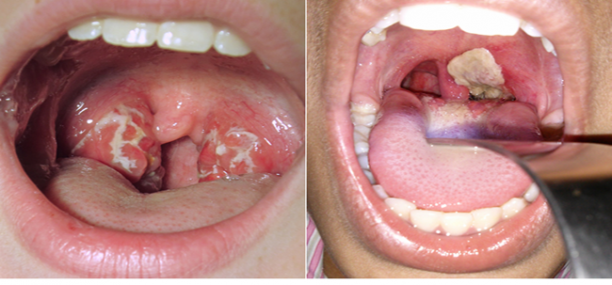Diphtheria
Diphtheria (Дифтерия, الدفتيريا) is a serious life threatening bacterial infectious disease caused by infection with Corynebacterium diphtheriae, an aerobic gram positive bacterium in the genus Corynebacterium that infects the mucous membranes of the throat and nose. When an infection is present, signs and symptoms can vary from individual to individual and can range from mild to severe.
Corynebacterium diphtheriae (a toxigenic bacterium) invades the mucous membranes of the host and secretes an exotoxin that destroys the cells in the nasopharynx (mouth, nose and throat) and inactivates eukaryotic elongation factor 2, a protein encoded by the EEF2 gene. Without prompt treatment, dead cells build-up and form a membrane blocking the throat .
If left untreated, diphtheria can lead to death by choking due to complete blockage of the airway
Classification of Diphtheria
1. Subclinical diphtheria (a preinfection) is a bacterial infection caused by Corynebacterium diphtheriae that is nearly or completely asymptomatic (bacterial carrier).
2. Diphtheria oropharynx, which is localized to the site of bacterial infection (a localized bacterial infection), accounting for approximately 98% of all cases. Oropharyngeal Diphtheria can be classified into the following localized forms:
A- Bluetongue
B- Ostrovchataya (acute) form of diphtheria
3. Diphtheria of the larynx:
A- Localized croup
B- Widespread croup
4. Diphtheria of the nose:
A- Catarrhal-ulcerous form
B- Glumaceous form
5. Diphtheria of rare locations:
A- Glumaceous
Common areas affected by Diphtheria include the eyes, ears, genitals, skin wounds.
Classification by localization
- Diphtheria of oropharynx and nose
- Diphtheria of oropharynx and larynx
- Diphtheria of oropharynx and oral cavity
Classification by Toxicity
- Subtoxic
- Toxic 1,2,3 degree
- Hypertoxic
- Haemorrhagic
Pathogen – toxigenic Corynebacterium diphtheriae.
Epidemiology
• Source of infection – a sick person or carrier (humans are the only reservoir).
• Mechanism of transmission: Diphtheria can spread by airborne transmission, via the aerogenic route, by inhaling aerosol droplets containing the bacteria (airborne disease), Less commonly, diphtheria can be transmitted by inhaling air dust particles containing the bacteria or by close personal contact with infected individuals.
Clinical picture
Incubation period ranges from 2 to 10 days.
Diphtheria oropharynx
Diphtheria oropharynx is characterized by an acute onset, symptoms usually develop suddenly and progresses quickly.
Intoxication syndrome expressed moderately, fever rises to reach 39 °c and lasts for 2x – 3x days, mild fatigue (weakness), and headaches may also be noticed.
Changes in the oropharynx: People with Diphtheria oropharynx suffer of oropharyngeal signs and symptoms such as swelling of the oropharynx, inconspicuous redness with cyanotic tinge on the tonsils, palate, the dorsal part of the throat appears gray and covered with a pearlescent tinged coat, the boundaries of which are clearly defined.
Removing the coat (film) is difficult, and if removed from a specific area or location, it may bleed. Moreover, the recurrence of pigmentation after treatment is common.
During the toxic form of oropharyngeal Diphtheria patients may also suffer of extra oropharyngeal symptoms such as swelling of the surrounding neck tissue, reaching the middle of the neck in 1st degree toxicity, the clavicle in 2nd degree toxicity, and below the clavicle in 3rd degree toxicity. Sugary-sweet smell from the mouth is characteristic.
Diphtheria of the larynx
People with laryngeal Diphtheria often suffer of symptoms such as fever, severe symptoms of intoxication, hoarseness, dry cough, shortness of breath, dyspnea, cyanosis, forced sitting position with the head thrown back.
Diphtheria of the nose
Anterior nasal diphtheria is characterized by a relatively gradual onset, symptoms usually develop gradually and progresses slowly. Patients may experience relatively mild symptoms that worsen gradually over a short period of time.
Intoxication syndrome: Symptoms of intoxication are expressed weakly. Patients often present with an elevated body temperature that ranges between 37ºC and 38ºC (low grade fever).
Changes in the nose: People with nasal diphtheria often suffer of symptoms such as nasal obstruction (when nasal passages are narrowed), swollen mucosa, erosion and septal perforation of the nasal septum, mucosal surfaces of the nose are coated with an isolated layer of viscous, thick, and sticky mucus.
Diphtheria of the skin, eye, ear, and genitals is a rare bacterial infectious disease characterized by fibrinous coats; However, the coating layers get thickened by thick and sticky fibrinous exudation (films) that can be difficult to remove. Moreover, edema occurs in most patients.
In toxic forms of diphtheria, patients often complain of a sudden onset of fever, spiking temperature elevation may reach 39-40°C. In most cases, intoxication is strongly expressed. Patients often present complaining of headaches, chills, vomiting, abdominal pain, weakness and lethargy. In addition, people with toxic forms of diphtheria suffer of other symptoms such as:
Swelling of the tonsils with diffusion on the palatoglossal arch, tongue, and mouth cavity (hard and soft palate).
Dense pigments on the tonsils, extending beyond them, diffuse redness of the mucosa of the oropharynx with cyanotic shade.
Regional lymph nodes are enlarged and painful.
Pain in the neck, subcutaneous edema in the neck, sugary-sweet breath, stenosis of the larynx, shortness of breath. Swelling of the subcutaneous tissue (1,2,3 degree) characterizes the degree of toxicity.
Complications: myocarditis, neuritis, nephrotic syndrome.
Differential diagnosis
Differential diagnosis is carried out with sore throat, infectious mononucleosis, anginal-bubonic form of tularemia, mumps.
Laboratory diagnosis
Bacteriological examination – swab from the oropharynx and nose, followed by sowing on selected medium. Serological diagnosis – TPHA, PHA, and ELISA.
Treatment
Etiotropic therapy: introduction of a specific anti diphtheria serum in accordance with the agreed instructions of use.
Antibiotic therapy: penicillin 6-12 million units / day, Cephalosporins, erythromycin, tetracycline.
Pathogenetic therapy – detoxification therapy, desensitizing agents, and corticosteroids (for patients with severe edema).
Symptomatic treatment: vitamin B supplements.
With the development of laryngeal stenosis – nasopharyngeal intubation, tracheostomy.
Prevention: mandatory vaccination.
Verified by: Dr.Diab (November 12, 2017)
Citation: Dr.Diab. (November 12, 2017). Diphtheria Epidemiology clinic and treatment. Medcoi Journal of Medicine, 22(2). urn:medcoi:article15977.














There are no comments yet
Or use one of these social networks